
Olimp and Yenisei-2: Russia’s secretive eavesdropping satellites (part 1)by Bart Hendrickx
|
| Luch has parked near more than two dozen commercial communications satellites for periods ranging from weeks to months. This is very unusual behavior for a GEO satellite. |
Some clues about the mysterious satellite had been given in March 2014 in an article published by the Russian newspaper Kommersant. Quoting an anonymous “highly-placed source” in the Russian space agency, it identified the satellite as Olimp (the Russian word for Mount Olympus in Greece, often incorrectly transliterated as Olymp) and its manufacturer as Information Satellite Systems (ISS) Reshetnev in Zheleznogorsk (Siberia), Russia’s leading developer of communications and navigation satellites. It would be used for both signals intelligence and communications and had been ordered by the Federal Security Service (FSB), the main descendant of the Soviet-era KGB. According to Kommersant, the satellite was so secret that only one of Roscosmos’ deputy directors was privy to the details of the mission and his further career reportedly hinged on its outcome. Kommersant also reported that the launch had been delayed from 2013 and was then expected to occur in late May.[1] The satellite had earlier appeared under the name Olimp-K in annual reports of several companies that supplied parts for it. The earliest reference to it was in 2008.
After it finally went into orbit on September 27, 2014 (September 28 local time), Luch first drifted to 54.0°E and remained there for three months, seemingly undergoing in-orbit checkouts. It then began moving across the geostationary belt, regularly stopping close to other satellites, something it continues to do nine years after launch. The first satellites it visited were the Russian communications satellites Express-AM22 and Express-AM33, the only Russian satellites it ever approached. Since then it has parked near more than two dozen commercial communications satellites for periods ranging from weeks to months. This is very unusual behavior for a geostationary (GEO) satellite, which usually spends years sitting at the same spot and relocates only sporadically, if ever at all. In addition to that, it has typically parked approximately 0.1 degree (roughly 70 kilometers) away from its target, much closer than the distance that is usually maintained between neighboring GEO satellites.[2]
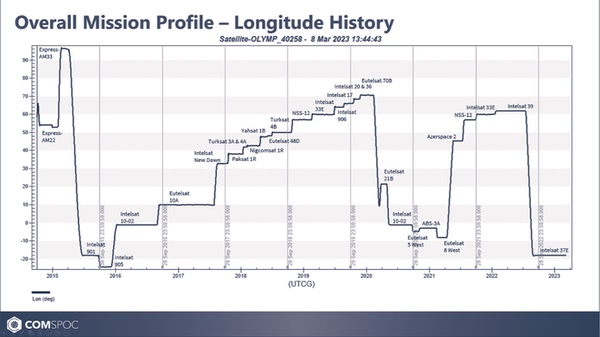 Satellites visited by Luch since its launch in 2014. (larger version) (credit: COMSPOC) |
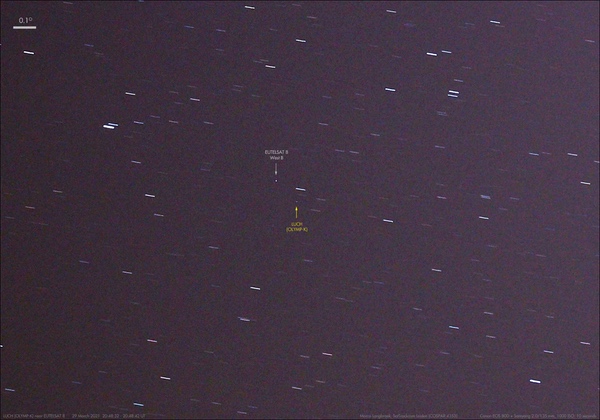 Dutch satellite watcher Marco Langbroek captured this view of Luch/Olimp parked next to Eutelsat 8 West in March 2021. Source |
Luch’s mission profile is very similar to that of two classified American satellites named PAN and CLIO, launched in 2009 and 2014. Some details on PAN emerged from secret documents leaked early last decade by Edward Snowden, a former intelligence contractor for the National Security Agency who fled to Russia in 2013. The documents revealed that PAN is part of a project named NEMESIS, the purpose of which was described as “Foreign Satellite (FORNSAT) collection from space”, more specifically “targeting commercial satellite uplinks not normally accessible via conventional means.” As stated in the documents, PAN would “provide the Office of FORNSAT ‘a site in the sky’ when denied a site on the ground for collection”.
FORNSAT is a branch of signals intelligence aimed at intercepting signals from foreign communications satellites. This task can usually be accomplished by eavesdropping stations on the ground if they are within range of an uplink terminal. Other National Security Agency documents in the Snowden archive revealed that it operated dozens such stations all over the globe. NEMESIS was apparently deemed necessary to fill the gaps in ground coverage, moving sufficiently close to satellites of interest to intercept whatever was transmitted to them in all the traditional frequency bands (C, Ku, and Ka). What also transpired from the Snowden files was that the US had used two of its ORION signals intelligence satellites to eavesdrop on the Thuraya-2 satellite, which relays mobile telephone calls from and to countries in the Middle East, Europe, Africa and parts of Asia.[3]
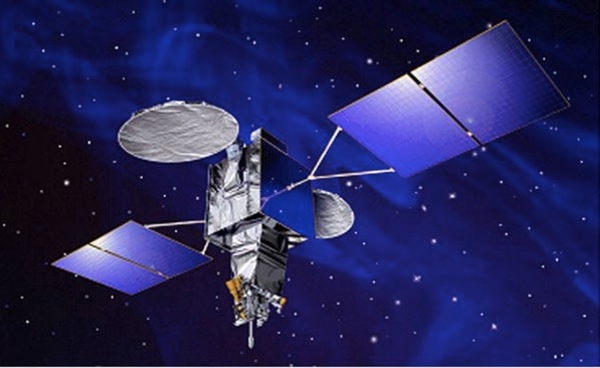 America’s NEMESIS satellite. (Credit: The Intercept) |
Judging from its maneuvers in orbit, there can be little doubt that Luch is on an identical mission. The typical 0.1-degree distance between it and its target is close enough for it to be within the ground uplink beam of the terminal communicating with the neighboring satellite. This is also as close as it got to the two Russian satellites that it visited early in its mission, which most likely served as testbeds to see how close it needed to approach them to intercept the uplink signal.
Currently, Luch is loitering near Intelsat-37e, which it has been shadowing since the summer of last year, longer than any satellite it has visited before. Its recent movements have been closely tracked by Kratos Defense & Security Solutions, a US firm which operates a global network of antennas capable of pinpointing satellite locations to within 100 meters. [4] A graph released by the company shows that Luch is not “parked” in the literal sense of the word since the physics of orbital dynamics dictate a constant motion relative to the other spacecraft. The distances between the two satellites continuously change, with Luch coming as close as 4 kilometers to the Intelsat satellite on October 31, 2022.
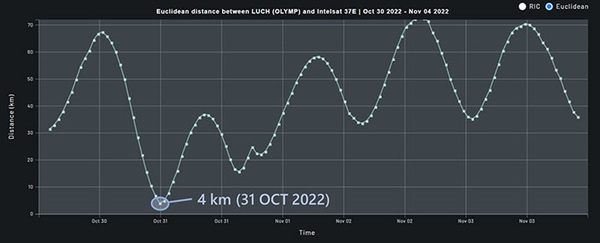 The “orbital dance” between Olimp and Intelsat-37e in October-November 2022. Source |
Despite such close approaches, only two satellite operators have openly expressed concern about Luch’s maneuvers. In October 2015, Intelsat criticized Russia for Luch’s “abnormal behavior” after it had maneuvered to within about 10 kilometers of two of its satellites earlier that year. It did underline that no attempts had been made to interfere with the satellites’ services.[5] In September 2018, French Defense Minister Florence Parly accused Russia of having performed an “act of espionage” by flying Luch very close to the French-Italian military communications satellite Athena-Fidus the year before. Closer analysis showed that Luch’s actual target during that particular period had been Paksat-1R, to which it came as close as 1.7 kilometers on November 27, 2017, the closest encounter reported for it so far.[6]
Kratos claimed that by coming so close to Intelsat-37e last October, the Russians disregarded conventions of the International Telecommunications Union (ITU), which sets tolerances for orbital slots in GEO at or above 0.1 degrees (70 kilometers). However, Luch is not unique in this respect. Also passing this threshold on a regular basis are America’s Geostationary Space Situational Awareness Program (GSSAP) satellites. Unlike NEMESIS, GSSAP satellites use optical cameras to take close-up pictures of objects in GEO. According to tracking data collected by the International Scientific Optical Network (ISON), which is managed by the Russian Academy of Sciences, GSSAP satellites have come as close as 10 kilometers to other satellites. Interestingly, the target of one such close encounter on September 14, 2017 was a satellite listed as Luch.
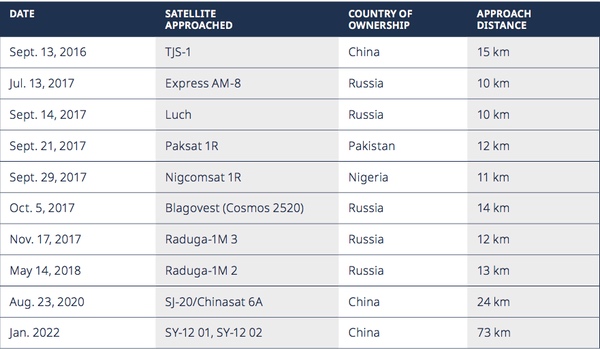 GEO satellites visited by US GSSAP satellites between 2016 and 2022. Source |
Assuming the following two satellites in the list were visited by the same GSSAP satellite, the Luch satellite in question must have been Olimp and not any of the three Luch-5 data relay satellites. Luch was in the same general neighborhood and itself went on to visit Paksat-1R and Nigcomsat-1R in the following weeks and months. From a range of just ten kilometers, GSSAP must have been able to take fairly detailed pictures of Luch, possibly giving analysts a fairly good idea of its capabilities.
While GSSAP may have furnished the US intelligence community with sharp closeup images of Luch/Olimp, there are no pictures or drawings of the satellite in the public domain. A search of Russian online sources turns up only a handful of design details. Obviously, the extensive maneuvers made by Olimp in the past nine years can only have been performed with electric thrusters. Two press reports in 2014 and 2017 (which don’t mention the satellite by name) make it possible to identify those thrusters as KM-60, a new type of Hall-effect thruster built for the satellite by the Keldysh Research Center in Moscow.[7] This is confirmed in an article published by the Keldysh Center which links the thruster to an unnamed ISS Reshetnev satellite launched in 2014.[8]
| From a range of just ten kilometers, GSSAP must have been able to take fairly detailed pictures of Luch, possibly giving analysts a fairly good idea of its capabilities. |
The KM-60 is a 930-watt thruster with a thrust of 42 millinewtons and an average specific impulse (over its entire lifetime) of 1,860 seconds. A unique feature is said to be its discharge voltage of 500 volts, which makes it up to 25% more fuel-efficient than similar thrusters. It is designed to operate for more than 4,000 hours and to be ignited up to 8,250 times. The 3.1-kilogram thruster is integrated with a power processing unit, a flow control unit, a feeding unit, and a tank (MVSK50) containing 71 kilograms of xenon. The engine underwent a 9.5-year development period that saw it work for a total of 4,120 hours during 8,357 burns. It is not known exactly how many of the thrusters and xenon tanks are on board Olimp.
 The KM-60 Hall thruster and its flow control unit. Source |
The KM-60 thrusters were ordered by ISS Reshetnev for a satellite platform known as Express-1000. This comes in several versions with masses ranging from about 1,200 to 2,300 kilograms and has a design lifetime of 15 years. According to a brochure published by the Keldysh Center in 2011, the KM-60 was intended for satellites with a mass of “up to 1,500 kg” and when the thruster was put on display during an exhibition in 2022, it was reported to be compatible with “lightweight geostationary satellites.”[9]
In a 2017 presentation of ISS Reshetnev, an unnamed satellite that is almost certainly Olimp was identified as being of the Express-1000H type, which has a maximum mass of around two tons (the values given by ISS Reshetnev differ).[10] Other satellites using this particular bus do have SPD-100V electric thrusters of the OKB Fakel design bureau. Olimp, the only satellite known to have the KM-60 thrusters, may therefore employ a unique version of the bus that is not seen in technical literature. Possibly, it has been adapted to enable the satellite to carry out more maneuvers than traditional communications satellites, for instance by reducing the mass of the payload or increasing the propellant mass. When equipped with the SPD-100V thrusters, the Express-1000H platform can carry a maximum of four MVSK50 xenon tanks, which translates into a total xenon mass of around 300 kilograms.
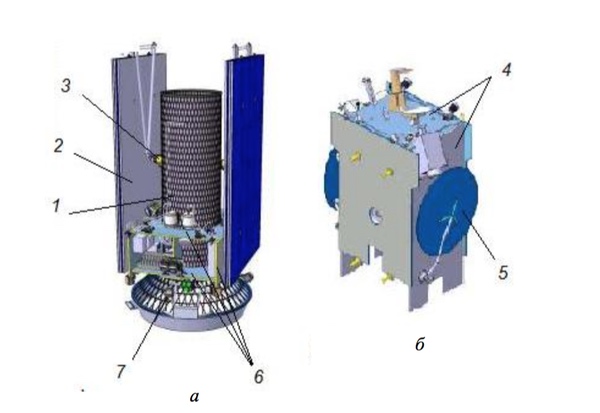 ISS Reshetnev’s Express-1000H satellite bus. Source |
An unknown Express-1000 type satellite is seen in a 2016 presentation of ISS Reshetnev. Three satellites shown here are said to belong to the orbital constellation of “RTRR” and “RP” satellites. The first abbreviation possibly stands for “radio-technical and radio reconnaissance” (the Russian terms for electronic and communications intelligence) and the second for “radio interception” (radioperekhvat in Russian), which is exactly what Olimp does. The satellite in the upper part of the slide can be identified as Repei, a new generation of signals intelligence satellites designed to pick up ground-based radio transmissions. The one on the left is an Express-1000 platform with two parabolic antennas. It is not seen in other publications and could be Olimp.[11]
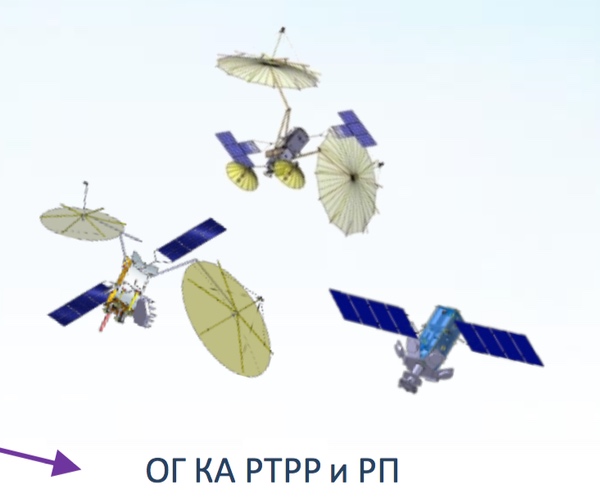 The satellite in the lower left is an unidentified Express-1000 type satellite that may be Olimp. (Credit: ISS Reshetnev) |
If Olimp weighs less than two tons, it was a relatively light payload for the Proton-M/Briz-M combination, which is capable of placing up to 3.5 tons into GEO. In fact, all the other Express-1000H type satellites have been launched along with other payloads. The secrecy surrounding Olimp may well be one of the reasons why it did not share a ride with a “regular” communications satellite. A special partition was reportedly erected around Olimp during its pre-launch processing at Baikonur to prevent unauthorized personnel (including foreign engineers working on other Proton payloads) from catching a glimpse of it.[12]
Also on board the satellite are so-called thermal catalytic thrusters (K50-10.5) of OKB Fakel. [13] These are monopropellant hydrazine thrusters commonly flown on ISS Reshetnev communications satellites in combination with electric thrusters. The electric thrusters are used for orbit corrections (both changes in altitude and longitude) and the chemical thrusters for attitude control.
Another novelty introduced by Luch/Olimp was a new type of lithium-ion battery (LIGP-50) developed by PAO Saturn in Krasnodar.[14] Also flown for the first time was a pair of fiber optic gyroscopes for the satellite’s inertial navigation system. Called VOBIS-1 and 2, they were developed by NPK Optolink in Zelenograd near Moscow, which is the hub of Russia’s microelectronics industry (sometimes called “Russia’s Silicon Valley”).[15]
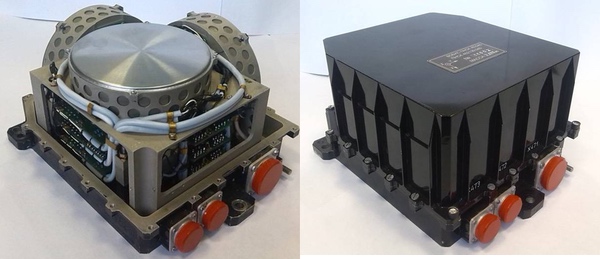 Olimp’s VOBIS fiber optics gyroscope. Source |
Other known subcontractors are NPP Kvant for gallium arsenide solar panels and NPP Geofizika-Kosmos for optical sensors needed by the satellite’s attitude control system. [16]
Very little is known about the payload(s) of Olimp. As can be determined from an online procurement document published in 2012, the company in charge of the payload, or at least part of it, is the Radio Research and Development Institute (NII Radio or NIIR) in Moscow.[17] NII Radio is an organization that builds both ground-based satellite dish antennas and payloads for communications satellites. It is also the prime contractor for a project named Sledopyt (“pathfinder”), a network of four ground-based signals intelligence sites that are intended to pick up signals from foreign satellites flying over Russia.[18] In that respect, its assignment to a project for in situ foreign satellite intelligence in GEO makes sense.
Little else can be learned from the 2012 document except that it appears to be related to a payload operating in the L-band of the radio spectrum. Another payload considered for Olimp was a 2.2-meter Ku-band antenna made of carbon fiber composites and aluminum honeycombs and weighing no more than 14 kilograms. This was mentioned in 2016 in a presentation of the Baltic State Technical University in St.-Petersburg, where it reportedly finished preliminary qualification tests in 2011 [19]. The development period is given as 2008–2012. The only other publication where the antenna is seen is a PhD dissertation published in 2014, some results of which were applied in the Olimp project.[20] Whether the antenna is actually on board Olimp is not known.
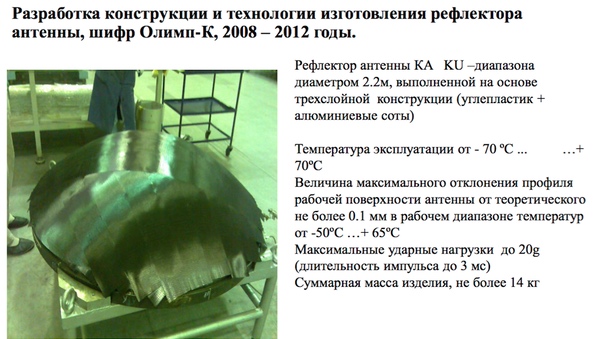 Ku-band antenna for Olimp developed between 2008 and 2012. Source |
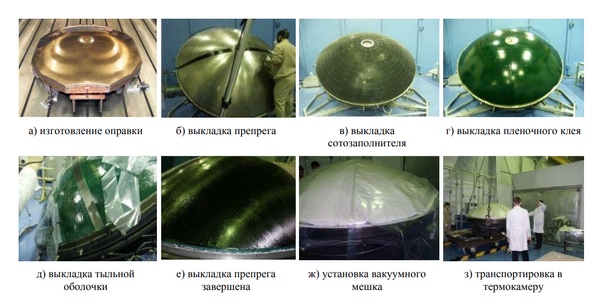 The same Ku-band antenna during various stages of production. Source |
| Whatever the eavesdropping payload of Olimp exactly is, it probably doesn’t look out of the ordinary. |
ISS Reshetnev’s former general director Nikolai Testoyedov wrote in a 2016 report that a “Luch type satellite” launched in 2014 had made it possible to perform flight tests of “a large-size 12 m unfurlable antenna for personal communications.” He could not have been referring to the Luch-5V data relay satellite launched in April 2014, because that only has much smaller antennas, leaving Luch/Olimp as the only other candidate. Still, that information was almost certainly inaccurate. The relatively light Express-1000H platform is most likely incompatible with such a large antenna. A 12-meter antenna for personal mobile communications had been supposed to fly as an additional payload on the Luch-4 data relay satellite, which was to use the heavier Express-2000 platform. After the cancelation of Luch-4 early last decade, Roscosmos came up with plans for a dedicated experimental mobile communications satellite called Yenisei-A1, which would carry a somewhat larger antenna and employ the even heavier Express-4000 platform. In a 2021 article, Testoyedov claimed that a 12-meter antenna would fly in 2023, but it looks like this is intended for a military communications satellite called Sfera.[21] There is no evidence that an antenna of that size has already flown on a Russian satellite.
Whatever the eavesdropping payload of Olimp exactly is, it probably doesn’t look out of the ordinary. Even though Olimp is essentially a signals intelligence satellite, it does not need to carry the huge antennas that traditional SIGINT satellites have to pick up faint transmissions from the ground. All it has to do is tune its equipment to match the channels in use, record the signals for as long as is needed and then relay them to the ground like an ordinary communications satellite. Similarly, America’s NEMESIS satellites are built on the basis of a standard communications satellite platform (Lockheed’s A2100 bus) and have relatively small antennas.
It has been speculated by some that Olimp may also carry one or more cameras to take close-up images of the satellites that it visits. While that possibility cannot be excluded, there is no evidence for the presence of imaging systems aboard the satellite. Since all the satellites visited by Olimp are commercial communications satellites, any pictures taken by Olimp would probably add little to what is already publicly known about them.
With a 15-year design lifetime, Luch/Olimp should have at least six years ahead of it. However, the fact that it has not changed position since the summer of 2022 is a possible indication that it doesn’t have much propellant left for further maneuvers. Another reason may be that its mission is being taken over by a new satellite launched earlier this year.
The first sign that another mysterious Luch satellite was being prepared for launch came in February 2020, when the general director of the Khrunichev Center (the manufacturer of the Proton-M rocket) told a visiting delegation that the launch of what he called a “Luch-5 satellite in the interests of ISS Reshetnev” was scheduled for launch in 2021.[22] By the time the satellite’s Proton-M rocket was shipped to Baikonur in March 2021, the launch had slipped to 2022. In its press release on the shipment, Khrunichev initially identified the payload as “Luch-5X” only to delete that information shortly afterwards. Since the next Luch-5 data relay satellite (a modified version called Luch-5VM) was not due for launch until the mid-2020s, it was obvious to observers that Luch-5X was a cover name for a possible successor to Luch/Olimp.
After several more launch delays, the Proton-M finally lifted off late on March 12, 2023 (March 13 local time). In a very terse launch announcement, Roscosmos reported that Luch-5X had been inserted into the planned orbit and would test “advanced relay and communication technology.”[23] The TASS news agency misleadingly called it another Luch data relay satellite “to exchange data between the ISS Russian segment and mission control.” When Russia officially registered the launch with the United Nations several weeks later, it described the satellite’s function as “relay of information.” The Roscosmos press release was accompanied by a picture purportedly showing the Proton’s nighttime launch, but this later turned out to be a file photo of an earlier launch. As can be seen in a webcast of the launch that later appeared on YouTube, the fog at Baikonur was so thick that even cameras close to the pad could barely see the rocket.
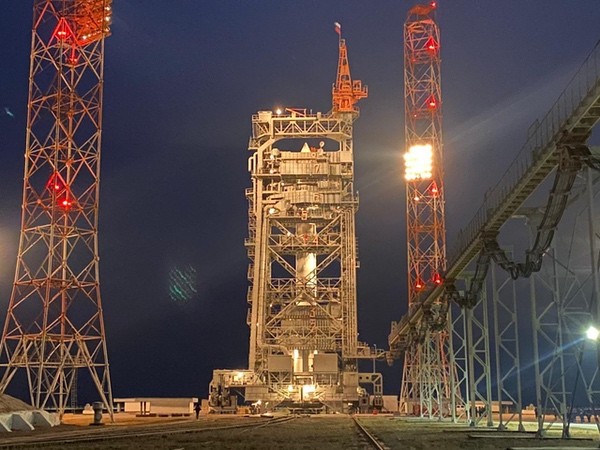 The Proton-M rocket with the Luch-5X satellite undergoing final launch preparations at Baikonur. Source |
After launch, Luch-5X slowly drifted to 78.7°E and then began moving backwards, finally coming to a stop at 58.0°E. This is where it appears to have undergone its initial orbital checkout, maintaining a normal distance of 0.5° with neighboring satellites. After about a month, Luch-5X resumed its westward trek. Unlike Luch/Olimp, it did not stop by any Russian satellites first and on May 22 it settled at 8.9°E, right next to two satellites, Viasat’s KA-SAT (formerly known as Eutelsat KA-SAT 9A) and Eutelsat-9B. This eliminated any remaining doubt that Luch-5X is on a mission similar to that of Olimp. The two satellites share a spot at 9.0°E, which is not uncommon for satellites owned by the same operator (KA-SAT was already at that location before it was purchased from Eutelsat by Viasat in 2020). Based on orbit analysis, only KA-SAT was a target for Luch-5X.
Luch-5X parted company with the two satellites on September 27 and one week later arrived at 3.2°E, right next to Eutelsat-3B at 3.1°E. All this undoubtedly is just the beginning of a long voyage through the geostationary belt that will see Luch-5X visit multiple satellites over the coming years. It is being closely monitored in the West, among others by two American startups (Slingshot Aerospace and DigitalArsenal) that are using advanced software and artificial intelligence to track the satellite’s movements and predict future targets. [24]
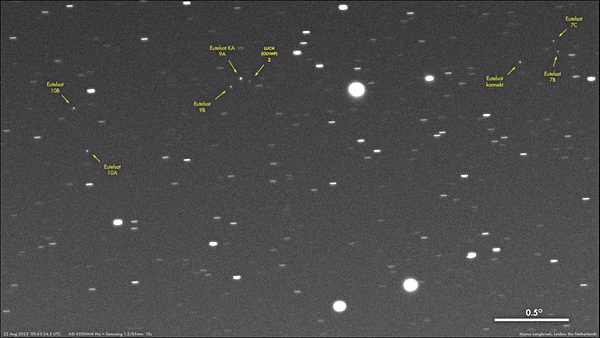 Marco Langbroek photographed Luch-5X parked next to KA-SAT (referred to here as Eutelsat KA 9A) and Eutelsat 9B on August 22. Source |
There are only two traces of a follow-up Olimp satellite in online procurement documentation. In early 2014, NII Radio, the company involved in building the payload for the first Olimp, awarded a contract for the development of so-called “pattern forming equipment” (DOA) for the project under the name Olimp-1 DOA. This was several months before the launch of the first Olimp satellite in September 2014, but the work was to take place in several stages and was not expected to be completed until 2019, meaning it was related to a second satellite. [25]
In late 2017, ISS Reshetnev ordered parts for a high-pressure xenon tank (KBVD) to be flown on an Olimp satellite. This is one sign that the second satellite is not a carbon copy of its predecessor. Whereas KBVD is a tank built in-house by ISS Reshetnev, Luch/Olimp carried one or more xenon tanks supplied by another company (the MVSK50 tank of NIIMash). The KBVD tanks come in several versions and are designed to fly on all of ISS Reshetnev’s Express platforms (Express-1000, 2000, and 4000), making it impossible to say whether the second satellite uses a different bus than the first one.
The first version (with a capacity of 350 kilograms versus the 71 kilograms offered by the MVSK50 tank) was flown on the Express-AM6 communications satellite, an Express-2000 type satellite launched in October 2014. Slightly improved versions were installed on two Express-1000H type satellites orbited in July 2020 (Express-80 and 103) and a much-upgraded model with a capacity of 500 kilograms or more was supposed to go up on the so far unflown Express-4000 platform. The KBVD tanks flown to date have been used to feed SPD-100V electric thrusters of OKB Fakel. Since the components that were ordered for Olimp’s KBVD tank in 2017 were to be delivered by OKB Fakel, the satellite may very well have those thrusters rather than the Keldysh Center’s KM-60 engines that are on board Luch/Olimp.[26]
The KBVD tank was designed mainly to give satellites enough xenon reserves in case they are not directly inserted into GEO by the Proton rocket and need to maneuver to their final orbit by themselves. However, unlike Express-AM6, 80, and 103, Luch-5X followed a direct-insertion launch profile. If it indeed carries the KBVD tank, it can use its full capacity for the extensive maneuvers that it is expected to make in GEO.
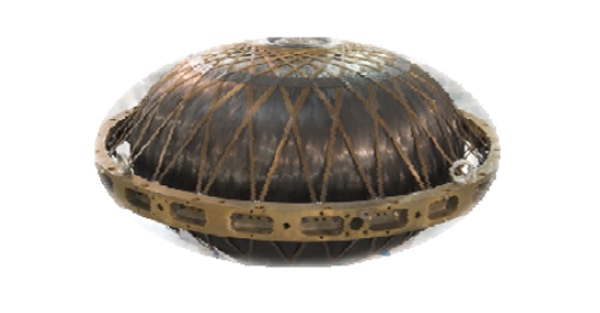 ISS Reshetnev’s KBVD high-pressure xenon tank. Its dimensions are given as 115.5 by 70 cm. Source |
Confusingly, there is also evidence for an ISS Reshetnev satellite that is clearly closely related to Olimp, but goes under a different name, namely Yenisei-2. (Yenisei is a river in Siberia.) It has turned up only in a handful of online procurement and court documents as well as in two short biographies of ISS Reshetnev specialists. [27] The dearth of information on the satellite is a sure sign that ISS Reshetnev wants to keep it out of the public eye. There is most likely no relation with the experimental mobile communications satellite Yenisei-A1, which has probably been canceled.
| The available information suggests that Yenisei-2 is a satellite using some of the same payload components as Olimp, but is not identical to it. |
The most valuable information on Yenisei-2 can be gleaned from a series of procurement documents placed online in 2014. From these it can be learned that Yenisei-2 is a GEO satellite with a design lifetime of 15 years. Despite the secretive nature of the satellite, there are no indications in the documents that Yenisei-2 is a military project. They do not reveal when and by which organization ISS Reshetnev was ordered to build the satellite. What is disclosed is that on February 1, 2014, ISS Reshetnev awarded two separate contracts for the satellite’s payload to NII Radio. NII Radio in turn signed several contracts for the delivery of payload components with the Izhevsk Radio Factory (IRZ). For the manufacturing and testing of some of these, IRZ was to make use of “stocks, technical documentation and equipment produced in the framework of the Olimp project.”[28]
Most of these components are subsystems that reveal little about the exact nature of the payload. Among the documents are contracts for three receivers, one transmitter, and four frequency converters, all of which are either identical to or derived from those flown on Olimp. One instrument mentioned in the documentation is called MAGD-O and intended to receive and process L-band signals between 1.5 and 2.5 gigahertz. Weighing around 14 kilograms, it consists of several so-called “group demodulation units”, each of which can receive two L-band signals and generate a digital output stream at a constant speed of 250 megabits per second (Mbps). Although Luch/Olimp also appears to have an L-band payload, MAGD-O is not linked in the documents to Olimp, which means it may be unique to Yenisei-2.
One of NII Radio’s subcontractors (the Special Design Bureau of the Kotelnikov Institute of Radio-Engineering and Electronics (SKB IRE)) provided an L-band switching system, presumably needed to route L-band signals from the satellite’s receiver to its transmitter. Another component not linked to Olimp in the documents is designated MPS and designed for “the receipt of information streams, their multiplexing and the formation of two streams with a speed of 320 Mbps”. In addition to that, it has to “mask the technical characteristics of the streams” by scrambling them. [29] Possible uses of these payloads will be discussed in part 2 of this article.
There are at least two indications that Yenisei-2 may have multiple payloads. First, NII Radio received two separate contracts from ISS Reshetnev for the project in February 2014. Second, one abbreviation seen in the documents is “BSK-2”, which stands for “On-board special complex 2”. BSK is a term applied to a set of instruments that together constitute a payload, so BSK-2 suggests there are at least two.
Virtually nothing can be deduced from the documentation about Yenisei’s 2 bus, except that it is equipped with electric thrusters. The 15-year design lifetime given for Yenisei-2 is typical of all ISS Reshetnev satellites being manufactured now, not only the Express-1000 bus, but also the heavier Express-2000 and 4000 platforms.
In short, the available information suggests that Yenisei-2 is a satellite using some of the same payload components as Olimp, but is not identical to it. The two also seem to have different internal project numbers at ISS Reshetnev. Some of the Yenisei-2 documents mention Project 763, wheras the serial number of Luch/Olimp (762V N°79448211) indicates it is part of Project 762 [30].
Evidence that the satellite launched as Luch-5X belongs to Project 763 comes from a study that assessed the environmental impact of the Proton launch that placed the satellite into orbit. The study was carried out by a team at Moscow State University (MGU) under the contract number 763-24/20/Luch/MGU.[31] It is quite common for project numbers to appear in such contract names. The same number is also seen in a contract for structural tests of the KBVD high-pressure xenon tank conducted for ISS Reshetnev by the Russian Academy of Sciences’ Institute of Computing Technology (IVT SO RAN) in 2019. [32] This is most likely the very same tank that was linked to an Olimp satellite in the procurement documentation released by ISS Reshetnev in 2017.
The conclusion is that Luch-5X is a sister satellite of Luch/Olimp, but has undergone enough changes to both its bus and payload to be given a new internal project number at ISS Reshetnev (763) as well as a new name (Yenisei-2). The names Olimp-2 and Olimp-K-2 seen in some online publications emanate only from Western sources. The earliest known contracts for the satellite were signed in February 2014, meaning that its development got underway well before the launch of Luch/Olimp in September 2014.
The launch of Luch-5X seems to have been delayed by at least two years. One reason for that may have been the need to incorporate changes into the spacecraft on the basis of the Luch/Olimp mission. Another could well be problems with the supply of foreign-built electronic components due to sanctions imposed on Russia by Western countries. Although Russia does not readily admit that the sanctions are having a major impact on the space industry, there are plenty of signs that this is indeed the case. Occasionally, the frustration over the delays resulting from the sanctions spills out into the open. For instance, during parliamentary hearings in June 2021, the then-chief of the Russian space agency, Dmitriy Rogozin, complained that nearly fully assembled satellites were grounded due to a lack of electronic components. “We have plenty of rockets, but nothing to place into orbit”, he said.[33]
Still, sanctions have clearly not stopped the Russians from ordering Western electronics for the eavesdropping satellites. Some of the Yenisei-2 documents placed online in 2014 stated that foreign-built electronic parts for the satellite’s payload could be selected from the “NASA Core Suppliers List,” a list of manufacturers that NASA considers preferred suppliers of microcircuits, transistors and diodes. Another online document published in 2020 gives a list of Western-built microcircuits purchased for a component of Yenisei-2’s payload named M-761A.
| Supplier | Component name |
|---|---|
| Firadec (France) | CTC 21 |
| 3D-Plus (France) | 3DEE1M08CS1193MS |
| STM (France) | RHFL4913ESY2505V, RHFL4913ESY3305V |
| Temex (France) | TE100EB21111M059 |
| MicroSpire (France) | CMC15 52K 2WR, SESI9.1 M10 2WR |
| Intersil (US) | IS9-705RH-Q, HS9-139RH-Q, HS9-26CLV31RH-Q, HS9-26CLV32RH-Q |
| Xilinx (US) | XQR17V16CC44V, XQVR600-4CB228V |
| International Rectifier (US) | ARE10005S/CKC, ARE10005S/EM |
| Glenair (US) | M83513/22-A 03NW-429C, M83513/22-B 03NW-429C, M83513/25-A 03NW-429C, M83513/25-B 03NW-429C |
| Spectrum Control (US) | 52-970-205-FA3, 52-970-205-HA1, 52-970-208-FB0, 52-970-216-FC1, 52-970-218-FC0, 52-970-208-FB1 |
| Harwin (US) | 221T22F22H, 221T04F22H, D308 6-99 |
| C&K (US) | 340100101BDEM9PNMB1A9N |
| TYCO Electronics | 5-1437514-9, 6-1437514-8 |
Such parts are not purchased directly by ISS Reshetnev or its main subcontractors, but by Russian intermediaries that act as go-betweens between the Russian space industry and foreign suppliers. For instance, a company named NPTs Shtandart acquired foreign-built electronic parts for Yenisei-2’s payload and then delivered them to another company (NPTs Eltest) for acceptance testing before they were supplied to NII Radio, the payload manufacturer. Delays in the delivery of such electronic parts were the subject of two court cases between these companies, but they seem to have resulted from bureaucratic issues rather than import restrictions.[34]
Like America’s NEMESIS satellites, Luch and Luch-5X have eavesdropped only on commercial communications satellites. The bulk of these belong to Intelsat and Eutelsat. The others are owned by smaller private operators (Yahsat, SES, ABS and Viasat) and by national operators (Turkey, Pakistan, Azerbaijan, Pakistan and Nigeria). Three of the satellites (Intelsat-10-02, Intelsat-33e, and NSS-12) have received two visits. The vast majority of the satellites operate solely in the C- and Ku-bands and only some also have high-throughput Ka-band payloads. Coincidentally or not, four out of five satellites visited since early 2022 have Ka-band capacity. These are Intelsat-33e and -37e, both targets of Luch, and Viasat KA-SAT and Eutelsat-3B, the first two satellites visited by Luch-5X.
| Luch changed its mission profile in the months leading up to the Russian invasion of Ukraine in early 2022. Since then it has visited only Intelsat satellites, spending more time in their vicinity than generally seen before. |
Exactly what kind of information Russia (and the US, for that matter) is trying to extract from the intercepted signals is a matter of speculation. One can assume that the main interest lies in data and voice traffic, possibly with the aim of carrying out economic and industrial espionage (economic espionage is one of the goals of US SIGINT satellites explicitly mentioned in documents leaked by Edward Snowden.) Moreover, many of these satellites provide services not only to private, but also government and military customers. For instance, the US and European militaries lease significant bandwidth on Intelsat and Eutelsat satellites, using them for a variety of traffic, from unmanned aircraft video feeds to mobile ground communications.
Some observers have drawn attention to the fact that Luch changed its mission profile in the months leading up to the Russian invasion of Ukraine in early 2022. Since then it has visited only Intelsat satellites, spending more time in their vicinity than generally seen before. The Intelsats in question (33e, 39, and 37e) transmit Ku- and C-band frequencies over Ukraine. These are often used for secure military communications.[35] Intelsat-33e and 37e, both belonging to the Epic series, provide both government and military users with high-powered Ku-band spot beams that enable bandwidth applications such as high-definition full-motion video using compact antennas for ground and maritime users. It is unclear though if they support any military operations in Ukraine.
It is also worth noting that Viasat’s KA-SAT fixed broadband network fell victim to a major cyberattack just hours before the beginning of the war on February 24, 2022. While the attack was not aimed against the satellite itself, it rendered inoperable thousands of Viasat KA-SAT satellite broadband modems in Ukraine, including those used by military and government agencies. It also impacted tens of thousands of Viasat customers across Europe. KA-SAT was a target for Luch-5X between May and September 2023, well after the attack took place. Although the satellite is unlikely to have any electronic warfare capabilities, it could potentially have gathered data on KA-SAT that might facilitate further cyberattacks. A report in Aviation Week last May claimed that attacks against the Viasat network were still ongoing at the time. [36]
Note: we are using a new commenting system, which may require you to create a new account.